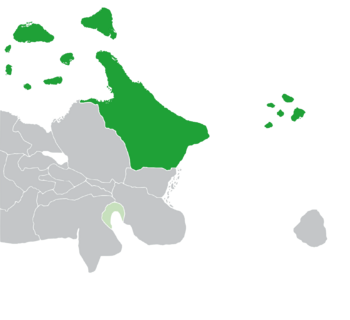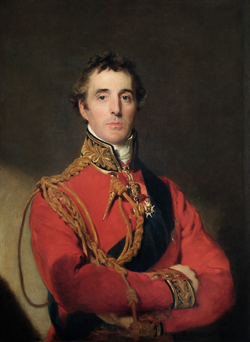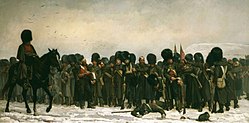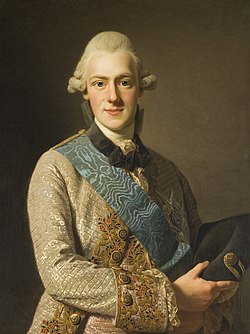Emerstari: Difference between revisions
No edit summary |
m (→History) |
||
| Line 160: | Line 160: | ||
===Middle Ages=== | ===Middle Ages=== | ||
In 422, the [[Emerstarian Confederation]] collapsed and of the many tribes that entered it, several petty kingdoms came out. The Kingdoms which were created from the Confederation were mostly Christian, but parts of Emerstari were still pagan, so for the next several centuries, copious religious wars were fought between the Christian petty kingdoms and those that were pagan, most notably the [[Vernian Cursade]]. | In 422, the [[Emerstarian Confederation]] collapsed and of the many tribes that entered it, several petty kingdoms came out. The Kingdoms which were created from the Confederation were mostly Christian, but parts of Emerstari were still pagan, so for the next several centuries, copious religious wars were fought between the Christian petty kingdoms and those that were pagan, most notably the [[Vernian Cursade]]. | ||
Revision as of 00:40, 25 August 2019
This article is incomplete because it is pending further input from participants, or it is a work-in-progress by one author. Please comment on this article's talk page to share your input, comments and questions. Note: To contribute to this article, you may need to seek help from the author(s) of this page. |
Federated Kingdom of Emerstari Foderelsk Kuingerike Emerige | |
|---|---|
| Motto: "Ervigner Hønnera åg Frihedt" "Eternal Honor and Liberty" | |
| Anthem: "Ervigner Rike" | |
 Location of Emerstari (dark green) – in Arda en' Estel (green & dark grey) – in the Emerstarian Empire (green) | |
 | |
| Capital | Coronet and Rensulier |
| Largest | Yoerk |
| Official languages | Emerstarian |
| Recognised regional languages | Canarian, Coelanish, Nordspreck |
| Religion | Lutheranism |
| Demonym(s) | Emerstarian |
| Government | Federal Semi-parliamentary Constitutional Monarchy |
| Erik XII Georg | |
| Erik Gjord Jakobssen | |
| Eugen Mikael Allenssen | |
| Johann Nathanael Theorissen | |
| Legislature | Foderelskkongress |
| Herrers Hus, Foderelsksammråd | |
| Folks Hus | |
| History | |
• Emerstarian Confederation established | AD 19 |
• Emerstarian Confederation collapsed | AD 422 |
• Kingdom of Emerstari established | AD 1047 |
• Eurevian Rebirth begins in Emerstari | AD 1444 |
• Federated Kingdom of Emerstari etablished | AD 1756 |
| Area | |
• | 644,050 km2 (248,670 sq mi) |
• Water (%) | 3.74 |
| Population | |
• 2019 estimate | 57,406,218 |
• 2015 census | 56,021,495 |
• Density | 89.13/km2 (230.8/sq mi) |
| HDI (2018) | very high |
| Currency | Shilling ( S) (ESK) |
| Time zone | Western Scanian Time |
• Summer (DST) | Western Scanian Summer Time |
| Date format | AD dd-mm-yyyy |
| Driving side | right |
| Internet TLD | .em |
Emerstari (Emerstarian: Emerige, pronounced [ˈɛmərjɛ]), officially the Federated Kingdom of Emertari, is a sovereign state and Scanian country in the Eurevian region of Arda en' Estel. Emerstari proper consists of its mainland and 416 named islands, with the largest beign Haller and Långeholt. The westernmost and northernmost of the Scanian nations, Emerstari lies north of Canaria and Roele and west of Coelans. The nation is generally mild due to its maritime influence and is characterized by flat to hilly arable land in the south and the west, by forested and mountainous land in the north, and by vast coastlines and lakes in the west. Emerstari has a total area of 644,049.75 km2 (248,669 sq mi) and land area of 24,094.66 km2 (9,303 sq mi).
Scanian peoples have inhabited Emerstari for 4,000 years, emerging into history as Emerstarians (Emerstarian: Emersk). A united Emerstarian state was founded in the early first century AD. After the fall of the Emerstarian Confederation in the 5th century AD, the nation divided itself into fourteen petty kingdoms in a period known as the Polyarchy. By the 10th century, all of these kingdoms had been Christianized, and in the mid-11th century, a reunited Emerstari reappeared. The Great Mortality in the late 14th century halved the Emerstarian population and indirectly caused extensive social and political changes and the War of Emerstarian Succession. The Kingdom of Emerstari consequently emerged as a major power and entered the Euervian Rebirth. During and after this period, an expansion of Emerstarian territories began and the Emerstarian Empire was formed. By the late-17th century, Emerstari was a dominant land and naval power, but in the mid-18th century, a new constitution was written resulting in the establishment of the Federated Kingdom of Emerstari. In the late-18th century, participated in the Wars of the Coalitions, entering first into the Fourth Oldraite Rebellion on the side of the Protestants. Emerstari shortly thereafter reached its territory height and entered into the Emerstarian Golden Age which lasted throughout the 19th century. The nation entered the 10 Years' War in 1911 a part of the Veidmaar League. After the war, an economic depression began that ended in the 1930s.
Today, Emerstari has close relations to its neighbors, culturally and linguistically as well as politically. It is a federal constitutional semi-parliamentary monarchy wherein executive power is vested in a Monarch. Legislative power is vested in the tricameral Foderelskkongress. Emerstari has seventeen states and two capitals, Coronet and Rensulier. Its national language is Emerstarian.
Etymology
The name Emerstari was loaned from the Marseilian word Emersterre in the 17th century. Before this, English used Emerland. While the Emerstarian name Emerige literally means "realm of the Emers," it is debated whether this word derives from Emer and rike (which is the more common interpretation), or if it derives from Emer and ige, an Emerstarian derivation of ia.
Variations of the name Emerstari are used in most languages, with exceptions of Coelanish, Jermanskan, and Svergian using Emerige, Halleran Emersland, and Øarnslandic Emíriki. Other notable exceptions include some of the Kolgrik languages where Eruortsi (Soumian) and Eruorški (Bohymish) are used. In the Elbaichish languages, Kualainn is used.
History
Early History
Emerish tribes migrating from what is present-day Rhenland reached Emerstari approximately 4,000-years-ago, following northbound herds of reindeer. However, a colder climate than that of today restricted settlement any farther north than the Vernij and Kjor Rivers for several centuries. By 1,400-years-ago, nearly all of Emerstari had been settled.
Proto-North Scanian, the predecessor of Old North Scanian, the common ancestor of all the modern North Scanian languages, diverged from Proto-Scanian around 1,000-years-ago, but it was not until 800 BC that a writing system was introduced, from the Marseilians.
Old North Scanian evolved from Old North Scanian 2,400-years-ago, and by this time, the tribes of Emerstarians were beginning to grow larger until by AD 19, several of the largest tribes in northern central Emerstari formed the Emerstarian Confederation. This Confederation was headed by a High Chieftain and mainly served as a defensive alliance. By AD 70, High Chieftain Folki Theorrisson had converted to Christianity, and the rest of the Confederation slowly followed suit.
Middle Ages
In 422, the Emerstarian Confederation collapsed and of the many tribes that entered it, several petty kingdoms came out. The Kingdoms which were created from the Confederation were mostly Christian, but parts of Emerstari were still pagan, so for the next several centuries, copious religious wars were fought between the Christian petty kingdoms and those that were pagan, most notably the Vernian Cursade.
Prior to their Christianization, pagan Emerstarians explored, raided, and settled various areas across Arda en' Estel; it is believed that in 723, one group may have reached so far as Durradon in Markion. However, the Emerstarian Viking Age finally came to an end in 912 when a league of Christian Emerstarian kingdoms took advantage of infighting between the Kingdom of Verni and the Kingdom of Valerige.
The King of Flodland, Eirikr Segersaella aimed to unite all of the Emerstarian kingdoms, an aim which never had been accomplished. When his uncle, the King of Whentii, died both kingdoms were united and he commenced an invasion of what is present-day Marland: first into the eastern Kingdom of Osteg, and then into the western Kingdom of Fjordland. By 1047, all of Emerstari had been united under his banner. Karl Gamla died in 1122, ending the rule of the House of Eirikr, and he was succeeded by Harald Berhjartath of the House of Sigfredsson, which reigned until 1235.
Letter from Olaf II Kristoffer to Karl VII and III.
By 1357, a plague which had spread across southern Scania reached Emerstari, and it lasted until 1359 when an especially cold winter killed off many of the bugs and rodents carrying it. The disease, the Great Mortality, halved the Emerstarian population and killed the only daughter of Olaf II Kristoffer. The death of her, Katarina Elisabet Olafsdottir, caused tension between Emerstari and Marseile resulting in Charles VII of Marseile invading Emerstari upon the death of Olaf II Kristoffer. He, however, died only a year afterward. Peter I and IV ascended to the throne of Marseile, and therefore the throne of Roele as well, and Emerstari. Sigismund I Kristoffer led a revolt against Peter I and IV in 1390; he established himself as King of Emerstari, installing the House of Saexe-Vittelsbach
Kristien I Ulrik, or Kristien Onreda (Christian the Unready), ascended to the throne of Emerstari after the death of his unpopular father in 1430, and ruled until his death from an isolated reoccurrence of the Great Mortality in 1439. From 1439 until 1444, the War of Emerstarian Succession raged across Emerstari.
Early Modern Era
Eurevian Rebirth

In 1444, after the end of the War of Emerstarian Succession, the House of Eirikr was reinstated, and Georg I Erik became King of Emerstari. Under his reign, Emerstari's state religion became Lutheranism, and the Emerstarian language was further standardized via the first Emerstarian translation of the Bible. Moreover, during his reign, Emerstari began to colonize outside of Scania. Erik I Georg is Emerstari's second longest-reigning monarch, from 1444 until 1512.
Christoffer Lorens Ljundstrom reached the Durranese coast in 1504, creating peaceful relations with the Durranese. He sailed throughout Markion from 1504 to 1512 and planted the seeds for Emerstarian colonies in Kophavien and Fyrland. Explorers after him colonized other lands in Markion such as Baveska, the Gyldenskkost, Klarsjoland, and Vasterkostland.
Emerstari grew wealthy from colonial trade and soon other Scanian nations followed suit. In 1552, war broke out between Emerstari and Marseile over the ownership of the Outoi Valley in present-day New Retermi. The war raged in New Retermi and off the coasts of both nations until 1556, but neither country was ever invaded; the Marseilians were ultimately bound by the Treaty of Uchtre to renounce their claim to the Outoi Valley.
A coalition of Catholic Scanian nations including Marseile, Roele, Estenland, Seubia, and Polsny, as part of a greater plan to reinstall Catholic monarchies across northern Scania, attacked Soumeland and Yermansk. In response, Emerstari, Canaria, Coelans, Saexeland, and several other duchies of the Scanian Imperium declared war on the Catholic League. Christened as the War of the Poiy League, it lasted from 1592 until 1628 and resulted in various territorial changes within the Scanian Imperium.
Amidst the war, Queen Katarina I Solveig died, and the House of Leijonhuvud was installed to the throne of Emerstari upon Ervin II Gustaf's ascension. Under the new Leijonhuvud rule, several provinces in modern-day Canaria were attained in 1672, forming Emerstarian Canaria.
Enlightenment and Golden Age
Carolinian Wars

In 1690, Karl IV Lorens ascended to the throne of Emerstari and upon this, he began to reform the Royal Emerstarian Military, and he created the Emerstarian allotment system. Aiming to take advantage of the 20-year-old king's inexperience, however, Saurland declared war on Emerstar in 1692 and invaded Emerstarian Soumeland. Karl IV Lorens proved himself to be one of Emerstari's best military minds, and in 1693, he forced Saurland into a personal union with Emerstari that would last until 1718.
The Polsnian Empire, aligning itself with the exiled King of Saurland declared war on Emerstari in 1695 and again, Soumeland was invaded. Throughout his Kuista and Erngia campaigns, Karl's army reached a total of 32,000 troops, — a number which would be surpassed during his 1700–1704 campaign. Polsny surrendered in 1697, handing over Kuistia, which was integrated into Emerstarian Soumeland, and Erngia which became an Emerstarian territory in its own right.
After three years, a coalition of several Scanian states led by Polsny declared war on Emerstari. Emerstari, allied with Coelans and supported by Marseile, forced Yermansk into signing the Treaty of Svalhavn within several months of the war's start. In the treaty, they had to break their alliance with Polsny. Thereafter, Emerstari simultaneous defended Soumeland from Polsny and Hessenland from Estenland. By 1701, the Polsnians had been forced out of Soumeland, and they retreated southward to defend Siesland. Karl, uniting his force with a Coelanish force, pursued them, and for three days near the village of Ruuken, the Emerstarian-Coelanish force fought the Polsnian force resulting in a combined total of 43,000 casualties.
Karl's army successfully took the northern half of Siesland and in 1702, Emerstari, Polsny, Coelans, and Estenland met to sign the Treaty of Solnatz. In which, Estenland was forced to break its treaty with Polsny and a two-year-long ceasefire was agreed to.
In 1704, the ceasefire ended and an Emerstarian army encountered a Polsnian force near the village of Kääjoki, resulting in the Battle of Kääjoki whereat, Karl IV Lorens was killed. The war continued on for several months after his death, and in the Peace of Poiy, the Polsnian Empire was forced to hand over Siesland which remained in a personal union with Emerstari until 1718.
Enlightenment
Karl was succeeded by his sister, Annette I Maria, who ruled for four years until her son, Ervin III Karl had reached of age, and she was asked by the Riksråd to abdicate. Ervin III Karl ruled from 1708 until his premature death in 1718, during which time, Emerstari remained at peace. He was a proponent of Emerstarian culture and the arts, and he ordered the construction of numerous cathedrals, palaces, and universities including the Emerstarian Academy which today is part of the Emerstarian Språkkeråd that regulates Emerstarian.

Ervin and his wife, Anaïs Magali de Donat, had one daughter who died in 1715 from pneumonia, and amidst the succession crisis that followed, Ervin III Karl was the target of an assassination carried out by Saurlandish rebels. The throne returned to the House of Eirikr, but the territories of Saurland and Siesland were lost.
Erik VIII Olaf who had served under Karl IV Lorens and held considerable territories in the Scanian Imperium ascended to the throne. He ruled from 1718 until 1744 and is known as the "Father of Scania", for he had eleven children and most Scanian monarchs today are related to him.
Excluding several minor colonial wars and a brief conflict with Kaltura in Markion, Erik VIII Olaf's reign was peaceful, seeing the expansion of the Emerstarian Empire and dominance of the Royal Emerstaran Navy. Erik IX Johann, grandson of Erik VIII Olaf, ascended to the throne following his father's death.
In 1749, talks of a new Emerstarian constitution began, and a draft was submitted to the Riksråd in 1755, and after a year of debate and revision, the Føreningpapper was approved by Erik IX Johann in 1756. A sizeable group of nobles, however, were concerned that the new constitution would limit their power. The new constitution also established seventeen states and reformed the Riksråg into the Foderelskkongress.
In Emerstarian Canaria in 1763, two years after the end of the Euteni War between Emerstari and Marseile, delegates from both nations signed the Voendenvelt Accords, establishing an alliance between the two nations as it was figured that it would be more beneficial to keep the current balance of power than to weaken one another.
Erik IX Johann died of stomach cancer in 1778, but as his eldest son and heir was visiting Gyldenskkost at the time, Erik's brother, Olaf III Aleksender, who had served as Emerstari's first president, ascended to the throne until 1780.
Erik's son, Karl V Erik, ascended to the throne in 1780. In 1782, pro-Sjovenians in the Emerstarian colony of Baveskjien declared their independence from Emerstari. From 1782 until 1790, they fought with Sjovenia against Emerstari. Ultimately, Emerstari ceded the colony in the Treaty of Kopmandsburg, and Johann Anderssen, the Head of Emerstarian Intelligence for the war, was hanged for treason. Karl V Erik had a day of national mourning for his death, having him put to rest in Tred Kronor Cathedral.
In 1792, Emerstari declared war on Estenland to, as it was put by Karl V Erik, in defence of Protestantism, for the Catholic Estenland invaded Neuresstedten. Although, it was mainly due to an alliance with Coelans. No Emerstarian king since Karl IV Lorens had personally led an army, and so, throughout the Wars of the Coalitions, Eirik Finn Felikssen–Leijonhuvud, the Duke of Whentii, led the Royal Emerstarian Military.
The Wars of the Coalitions lasted from 1789 until 1831, but Emerstarian involvement lessened after the establishment of the Venson Union in 1818. In the 1820s, the Royal Emerstarian Navy was the uncontested dominant navy in Scania, and Emerstari entered into the Emerstarian Golden Age, reaching its territorial height.
Golden Age
Starting in the 1820s, several Emerstarian authors rose to prominence including Hans Karl Anderssen, Theodor Georg Kierke, and Lorens Olaf Perssen. Numerous Emerstarian painters also became renowned around Scania including Osvald Ragnvald Strom and Svea Karla Gjordsdottir. Emerstarian composers Ludvig Ingvar Georgssen and Ragnvald Thomes Stenhammer lived during this period as well.

Industrialization began to rapidly spread in Emerstari during the 1830s and 1840s, and in the 1850s, some of the first railroad tracks were set in Emerstari, creating the basis of the Riksjørnvag. During this period of industrialization, Folke II Knudt died, in 1849, and ended the real union between Emerstari and Emerstarian Canaria.
In 1862, a monetary union was established between Emerstari, Coelans, Saurland, Canaria, and briefly, the Friedish Confederation which was absorbed by Coelans. The currencies, all of which in their native languages translate to "shilling", were on the gold standard, and one shilling was defined as 1/1100 of a kilogram of gold.
The Emerstarian Golden Age was largely peaceful, with only a few colonial wars, but in 1873, Kristien II Gustaf declared war upon Seubia wherewith, tensions had been growing for years about the fate of Emerstari's personal union with Hessenland.
For the initial two years of the year, Seubian forces won the majority of the battles; however, in 1875, the war turned in favor of Emerstari, and by the fifth year of war in 1878, a white peace was agreed to in the Treaty of Leipze. Hessenland, however, voted in a referendum in 1880 to become independent. After months of discussion with the Foderelskkongress, an agreement was reached that in 1885, it would be set free. A member of the House of Eirikr, and cousin of the Carl Augustus IV of Saexeland, was made king. Upon the death of the Carl Augustus in 1891, Georg Johann I was also crowned King of Saexeland.
In the 1890s, Emerstari loosened restrictions on immigration, but these restrictions would be reinstated and made stricter after the 10 Years' War, during the Scanian Depression.
Modern Era
20th century
Emerstari fought as a part of the Veidmaar League in the 10 Years' War. Its forces engaged primarily in southern Scania near Estenland, along the coast of Ienkelland, and briefly south of Soumeland. This was the last war wherein the Emerstarian Home Guard was called to war via the allotment system.
After the war, Emerstari, like Marseile and Ienkelland, began to decolonize; although before the war, the real union with Canaria and Soumeland ended in 1849 and 1904 respectively, and the colony of Fyrland had been given to the Green Union in exchange for the Tryndal Islands in 1871. New Retermi was one of the first colonies to leave after the war, in 1931.
Emerstari became one of the first countries in Scania to develop a nuclear arsenal (with its first atomic bomb test in 1957), in response to the development thereof by Socialist Renochesvia. In 1967, the Venson Union Defence Council voted to aid the Slovyan rebels in the First Slovyan Insurgency. Emerstari, Rolech, and Canaria sent ground forces to Slovya in 1968. After several large losses, Emerstari pulled its forces out in 1970 but continued sending supplies until the Renochesvian victory in 1971.
21st century
In the national elections in November 2010, voters ended twelve years of Vernon rule, returning the Monarchic-Republican Party to power by electing Erik XII Georg to the presidency. Erik XII Georg refused to run for a second term, and in 2014, Erik Gjord Jakobssen was elected, running as a Federalist. He was elected on promises of tax cuts, more spending on the Riksvag, and to be tougher on socialist Renochesvia.






